Peter Zeihan: Charting the Path to Supply Chain Resurgence and Technological Transformation
Within thirteen or even fourteen years, a paradigm shift emerged, allowing the ascension of a president who embarked upon the path of policy enactment. Such a development, dear reader, bears the semblance of novelty. From my vantage point, a leader has emerged, exhibiting an earnest desire to fulfill the role of president in a manner befitting the title. As fragments coalesce, an industrial policy takes shape, albeit one that may not receive the unanimous endorsement, for I, too, find myself at odds with certain aspects. Nonetheless, endeavouring itself merits recognition, evoking a sense of admiration.
Engage in contemplation regarding investments that can yield benefits amid this reversion to North American grounds. Should you be inclined to employ a political stratagem, direct your efforts towards lobbying the members of Congress, imploring them to effect reforms in Jones, for such an endeavour, I posit, presents an uncharted realm of boundless opportunities.

Let us now direct our attention to digitization, a domain that has struggled to maintain pace with the swift strides in industrialization. Embracing modularity and adaptability, these hallmarks of progress, afford one a substantial advantage. Our present circumstances differ markedly from the erstwhile systems characterized by intricate webs spanning Malaysia, China, and Vietnam, where each component's journey contributed to a convoluted intermodal dance. Instead, we are poised to condense the supply chain, allowing for fewer stages closer to our shores. This forthcoming transformation, bearing a competitive character distinct from its predecessor, compels us to engage in multifaceted endeavours. We can no longer content ourselves with mere capacity amplification; instead, we must cultivate awareness of the minutiae encapsulated within each container. An all-encompassing knowledge accessible to all, revealing optimal paths to traverse this intricate labyrinth, necessitates assimilating technological advancements. Notably, early signs of manufacturing revival have already emerged, exhibiting promise on a grand scale.
Let us delve into the linguistic duality inherent in this paradigm shift—a shift wherein the demand for North American goods necessitates rendering information accessible in English and Spanish. Moreover, our efforts shall require traversing borders, time and again, attending to the intricacies of multiple product categories. Within this milieu, the role of robotics emerges as a potential panacea. Yet, let us proceed with caution, for it behooves us to acknowledge the considerable expenses incurred in adopting physical automation. Robotics, a domain marked by its onerous fiscal burdens, necessitates more than a solitary investment. Sustaining such automation demands continuous financial commitments, encompassing programming and system updates. Thus, while robotics and automation can undoubtedly constitute vital components of the solution, they do not represent a cure-all for the challenges that lay before us.

Nevertheless, I implore you to recognize the virtues entwined within the digitization of cargo information. An omnipresent understanding of the contents within each container, granting all parties the ability to ascertain the precise status of their supply chains, stands as a commendable aspiration. By invoking this example, allow me to illustrate the ramifications of an unforeseen event. Consider a hypothetical scenario wherein one of the colossal containerships, like a Tripoli, were to encounter misfortune off the coast of Japan. The resulting consequences would entail an arduous undertaking, stretching over months, ascertaining the contents consigned to the depths.
In contrast, we primarily rely on trucks and railways, a more manageable and localized system when contemplating domestic or North American transportation. This shift provides us with an opportunity for closer examination and experimentation in digitizing the supply chain. We can optimize and refine our processes through this lens, thus enhancing efficiency and adaptability.

In summary, the emergence of countries committed to policy enactment signifies a significant paradigm shift. While the industrial policy may evoke differing opinions, the endeavour warrants acknowledgment and admiration. For those involved in shaping the future of supply chains, reversing North American grounds presents unexplored potential. Embracing digitization and modularity, we can reshape the supply chain landscape, bringing it closer to home and enabling swift adaptation. However, while robotics and automation offer promise, their implementation should be approached cautiously, considering the associated costs and ongoing investments required.
The digitization of cargo information emerges as an admirable goal, allowing for real-time awareness and optimization within the supply chain. This knowledge empowers stakeholders to navigate unforeseen events with efficiency and precision. As we embrace this transformative journey, it is vital to recognize the unique opportunities presented by localized transportation systems and the integration of advanced technologies.
Daniel's Take:
- The ascension of governments dedicated to policy enactment marks a notable paradigm shift.
- The reversion to North American grounds opens up the uncharted potential for supply chain builders.
- Digitization and modularity offer advantages in optimizing the supply chain and adapting to change.
- Robotics and automation should be approached thoughtfully, considering cost and ongoing investments.
- Real-time digitization of cargo information empowers stakeholders to navigate unforeseen events efficiently.
- Localized transportation systems and technology integration present unique opportunities for progress.
Cameron's Take:
When the Covid-19 pandemic started in 2020, I was reminded of something my Dad told me when I was a boy. He always remarked that the whole country was always 7 days away from empty store shelves. As I stood in the Food Lion in Charlottesville, Virginia, grabbing the last package of rice and other items, I was reminded of this little story from my Dad. I will admit that I never thought I would see empty store shelves in the United States. I've seen them in other countries but never thought I'd see them in my home town. It was eerie to walk down the aisles and see bare shelves. I hadn't seen many open shelves since I worked in retail at a high-traffic location. I don't think most people, even policymakers, realized how delicate and fragile our system of supply lines had become.
Supply chain logistics had been outsourced and spread so thin that any disruption had implications across the entire system. A lack of computer chips meant that cars were sent down assembly lines without the computers they needed. Used car prices skyrocketed, and I was lucky to nab a new-to-me car before that happened. However, my car (a Subaru Forester) briefly increased in value so that I could have sold it for a profit in 2021.
What did the world learn from this? Supply chains are essential, and they need to be low-cost but resilient. Companies had perfected the low-cost part but not the resilient part. This resulted in significant disruptions and billions in losses. The trend is to shorten supply chains and create a more resilient supply that can withstand minor disruptions. We are in a time of turmoil. History is happening right outside our doors, which presents business challenges. This is where the North American powerhouse idea from Zeihan is so essential. While the rest of the world descends into chaos, North America can become an economic dynamo that is very much separate from the general chaos elsewhere on the globe. This could lead to growth, investment capital, and new businesses throughout the continent.
However, it should be noted that those who look to the past for guidance on a resurgence of American prosperity do not be fooled. The new factories and warehouses will be highly digitized and automated. The US still produces 5,000 million tons of steel annually, and we do it with 1/3 of the people it took 40 years ago. That being said, there is still tremendous opportunity for people to start a new business, find a new job, and enjoy the growth that is likely to occur.
Geopolitically, this will create an exciting dynamic. People fleeing more chaotic areas of the planet will likely seek to immigrate to the North American powerhouse in more significant numbers. This will create political issues domestically and will undoubtedly develop pressures on domestic services, housing, etc. To fully take advantage of this, politicians and planners should consider what is coming over the next 5-10 years and begin streamlining building housing, infrastructure, and other hard assets that will allow this growth to occur. If this isn't considered, a huge opportunity could be wasted as growth is constrained by chokepoints at ports, airports and highways. Fortunately, the Biden administration is already leading in this area by rehabilitating the nation's infrastructure.
As a warning, the government should also incentivize companies to spread out this new growth. Over the past few years, one of the difficulties is that most of the economic growth has been concentrated in a few superstar cities like Seattle, San Francisco, New York, Los Angeles, Denver, Houston, and Austin. This has led to a housing squeeze in these places and has caused prices to become unsustainable for local people, especially service workers and others who have been pushed out of these places. The prosperity of the 20th century was booming, due in no small part, to the fact that companies left cities and built facilities all over the country in small towns and medium cities. This meant that the economy's success was shared with most people, not just those who could swallow the price of housing and services in major cities.
We are on the precipice of great opportunity; if we can make it sustainable, shared, integrated, and automated, then a new age of prosperity could be upon us, but it will take wise policy and management from companies and all levels of government to truly harness this new North American story.
Speculating on the Good (καλός) related to this writing:
We can envision a future where supply chains become more resilient, efficient, and responsive. The efforts to embrace digitization, modularity, and localized transportation systems hold the promise of streamlining operations and fostering adaptability. As stakeholders unite in advocating for reforms and investing in innovative solutions, the supply chain industry can witness a transformation that benefits businesses and contributes to North America's overall economic growth and prosperity.






